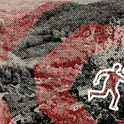Paul Bocuse died in January at the age of 91 above his family’s restaurant, L’Auberge du Pont de Collonges, outside Lyon, in the same room in which he had been born.
“I am lost when I leave,” he once said, “when I spend a night in another bed, to find my bearings, I have to fall asleep with the river Saône situated on my left.” Because Bocuse; the chef who held three Michelin stars for more than 50 years and was for decades the embodiment of French cuisine: tradition and terroir.
As a teenager, Bocuse was wounded fighting for the Free French against the Germans in 1944. After the war he began his training under Eugénie Brazier, the first female chef to achieve three Michelin stars. Brazier grew up poor on a farm in Bresse. In her book La Mère Brazier: The Mother of Modern French Cooking, she recalls a soup that her mother brought to her while she was tending pigs in the field—leeks and vegetables cooked in milk and water, enriched with eggs and poured over stale bread for substance—saying she had “never eaten better.” From Brazier, Bocuse learned la cuisine familiale; the simple brilliance of fresh ingredients carefully rendered.
After his stint with Brazier, Bocuse spent eight years at La Pyramide in Vienne, under the legendary chef Fernand Point. In Point, Bocuse had the example of a celebrated chef and the rigour of perfection. Point was enormously fat—“regard the chef,” he said, “if he is thin I will probably dine poorly.” Point also held that you had not mastered a dish until you had cooked it 100 times.
In the pantheon, Point was the original, Bocuse the apotheosis, the epitome, even the cartoon. Tall white toque hat, the tricolor collar of his chef’s white jacket denoting the award of meillure ouvrier de France, arms folded across his chest, a burnished battery of copper pans as backdrop: Bocuse was a self-publicist nonpareil.
When he earned his third Michelin star in 1966 he bought back the original restaurant that his grandfather had been forced to sell in 1921, and erected a giant neon sign reading “PAUL BOCUSE” on the roof. More than anyone, said the chef Jacques Pépin when Bocuse was named chef of the century by the Culinary Institute of America in 2013, Bocuse had brought chefs out of the kitchen and into the dining room.
My boyfriend took me to L’Auberge du Pont de Collonges in 2015. The restaurant is on the old road to Lyon that runs along the pretty Saône river bank. You can’t miss it. The house is bright green with red shutters, the walls have painted murals of proud French cockerels and elaborate platters of food with a grinning Monsieur Paul looking out from a trompe l’oeil balcony.
By 2015 Bocuse was no longer in the kitchen. As his empire had expanded to include outposts in Japan, Switzerland, Epcot Centre Disney World, as well as a string of regional restaurants in Lyon overseen by his son, his body was succumbing to Parkinson’s disease.
We were shown to a table in the annex conservatory, an elegant Siberia. We sat among six or seven tables: all foreign couples. Japanese, American, Lebanese. The waiters glided among us, formal, their movements graceful and brisk with a hint of curt insouciance in their discretion. I am not intimidated by sommeliers, curlicued menus or hovering maître d’s. Nonetheless I pulled my scarf around my shoulders, it was chilly.
The other couples ate in near silence, the atmosphere was temple tomb. They all ordered the famous Volaille de Bresse vessie Mère Fillioux and we watched as the waiter arrived with a succession of steaming pigs’ bladders on silver platters and then deftly cut into them. The balloon-like bladders deflated to reveal a whole pale-skinned chicken with slivers of black truffle showing through its skin.
I ordered one of the other famous dishes, truffle soup, which seemed de rigueur in such a hallowed museum. It arrived with suitable aplomb, in a bowl emblazoned with the legend of its birth: PAUL BOCUSE: Soupe aux truffes noires VGE (for Valéry Giscard D’Estaing), first served at the Elysée Palace, 1975.
My mother had eaten this dish 30 years before and had described to me her raptured astonishment at the heady truffled steam which poured out when she first broke through its golden puff pastry dome. Maybe because I was expecting to be amazed, I was not. It was nonetheless an excellent soup: a dark umami velvet chicken broth, thickened with foie gras and egg yolk.
I did not taste the truffle. I know truffle is an elusive undergrowth scent—but still. But still. Somehow with all the theatre, display and decoration and the vaulted occasion, I nodded, giving in. Yes, delicious.
The menu was a classical symphony of haute French cuisine. Foie gras à la Antoine Carème, sole à la Fernand Point; fricasée of Bresse chicken with morels, beef Rossini, roasted pigeon, lamb with thyme. I ordered the ris de veau, sweetbreads, which came in an ivory cream moat with chanterelles and morels. My boyfriend ate a tower of beef weighted with a slab of foie gras and capped with a fluted mushroom surrounded by a jus gravy of such chestnut glossiness if looked like molten racehorse.
Our meal was the essential and eternal marriage of cream, butter and wine. Bocuse was sometimes accused of being one of the founders of nouvelle cuisine, but he never liked trends, whether fusion, vegetarian or molecular. “For me there exists only one cuisine, ‘the good one.’” The weight of the past hung as heavily as the thick damask tablecloth. We chose baba au rum from the dessert trolley and nibbled our petit fours, soothed by the gentle waves of brown and white and by the heft and portliness of the red wine glass. We were very tired.

Paul Bocuse
The chef who built an empire
One man above all came to embody the notion of what it is to be a French chef—so I went to his restaurant
April 18, 2018











